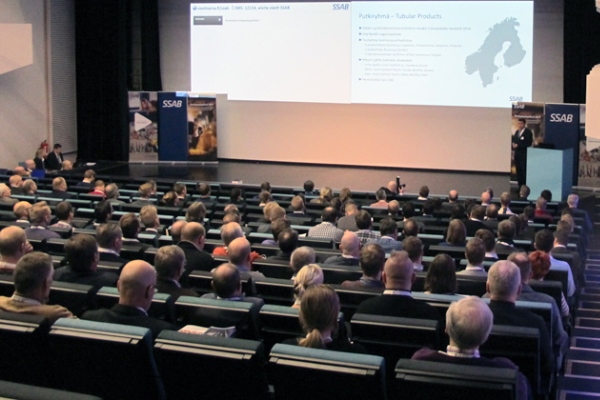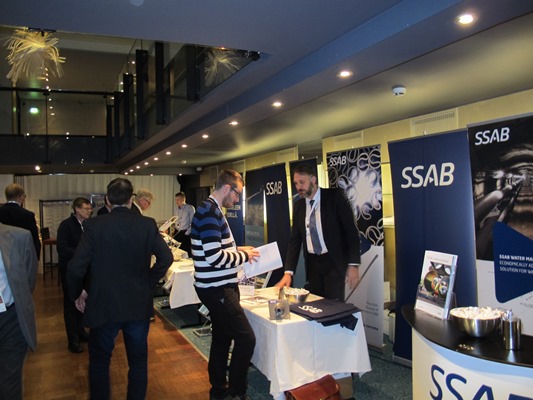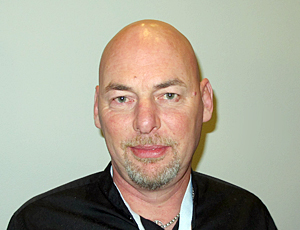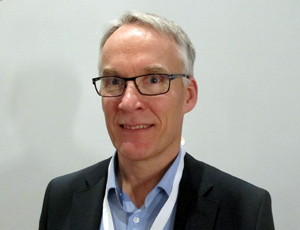SSAB’s tenth Steel Pile Day 2017 in Helsinki
A total of 300 foundation construction experts gathered together for SSAB’s Steel Pile Day held in Helsinki on January 19, 2017. Contractors, designers, authorities and students who participated in the event were offered an introduction to SSAB’s pile products. The event also showcased projects in which the company’s RR and RD piles have been used to construct dock structures and building foundations.
Figure 1. A total of 300 foundation construction experts gathered together for SSAB’s Steel Pile Day held in Helsinki on January 19, 2017.
Kari Väliaho, General Manager, Tubular Products opened the tenth ever foundation construction event. Developed in Finland, RR and RD piles have been in use for three decades now. Driven steel piles were used for the first time in the construction of the dock in Oulu’s Oritkari in Finland, and the expansion of Imatra’s cardboard factory in 1987 represents the first-ever micropile application. The majority of the piles produced by SSAB are exported.
‘SSAB has full control over its production and processing chain. All our steel pile products are manufactured at our own factories using steel produced in Raahe. This allows us to control the entire process, offer reliable deliveries and ensure that our piles meet the quality and product requirements. Our products are delivered to customers cost-efficiently by road from the factories or from our subcontractors’ premises,’ explains Marko Maukonen, Supply Chain Manager, Infra.
Use of RR and RD piles and RD pile walls in customers’ building projects
Project Manager Reino Heikinheimo from Ramboll Finland Oy introduced Turku University Hospital’s T3 project in which HDPE RD® piles were used for the foundation. With the new building built on top of a railway and motorway, the project was extremely challenging.
Roger Starck from the Swedish company BESAB AB talked about projects carried out by the company where SSAB’s RR and RD piles had been used to reinforce the foundations of old or historical buildings.
Construction Manager Pasi Mäkinen from Skanska Infra Oy presented the company’s K6 office building project. The 8-storey building, which has 3 additional floors underground, is located in a densely built area in Sörnäinen, Helsinki.
Piet van Breukelen from SSAB introduced an RD pile wall project carried out at Peterhead Port in Scotland, which represents our most extensive pile wall project outside the Nordic countries to date.
YIT-Rakennus Oy’s construction manager Juha Vunneli offered an update on the progress of the PasilaTripla project in Pasila, Helsinki. The project involves the construction of a shopping centre Tripla, high-rise buildings and a new residential area.
In his presentation, Antti Perälä Technology Manager, Infra covered the Hospital Nova project in Central Finland and the Kiiruu School project in Somero, in which the steel grade of RR and RD piles was upgraded to S550J2H, which resulted in considerable savings.
Figure 2. In addition to the presentations, the event included an exhibition of SSAB’s products
New products and updated dimensioning programs
SSAB’s range of driven micropiles has been complemented with new driven pile elements made of high-strength steel (S550J2H), such as the RRs220/10 and RRs220/12.5 piles.
Steel Pile Day also showcased the company’s expandable rock bolts (ERBs), suitable for reinforcing road tunnels and mines. SSAB has three decades of experience in manufacturing ERBs at its factory in Virsbo, Sweden.
SSAB’s dimensioning program RRPileCalc 2.9.0.0 was updated in January while the PileWallCalc 2.01.0 program now also includes the Swedish and Norwegian standards.
SSAB has also launched a new dimensioning program, FrameCalc, which covers SSAB’s standard dimensions and steel grades from S355 to S700. The solution is designed for the automated design of steel trusses.
In addition, Tibnor’s product range was introduced to infrastructure builders at the event, including sheet piles and beams required in the construction of sheet pile walls.
Participants’ comments on Steel Pile Day
‘We have used RD piles and RD pile walls in applications such as foundations for industrial buildings. I was particularly interested to hear the presentations by contractors and to learn more about their experiences of these products,’ says SRV Infra Oy’s construction manager Janne Viitasalo, who participates in the Steel Pile Day almost every year.
‘Bringing together all the designers and contractors, this annual event offers an opportunity to meet face-to-face with collaboration partners you usually communicate with by phone or email,’ he adds.
Figure 3. Janne Viitasalo, SRV Infra Oy
Miia Paatsema, a project manager at the City of Helsinki Geotechnical Department, is another regular at the Steel Pile Day.
‘I was particularly interested in the Scottish port case, which provided me with new ideas on how to proceed with the design of our project. We could utilise the guide frame that was used in the installation of the pile wall in the port project,’ says Miia Paatsema.
Figure 4. Miia Paatsema, the City of Helsinki, Geotechnical Department
Construction manager Sami Kari from Lemminkäinen Infra Oy is also a familiar face at the annual event.
‘We have used SSAB’s piles in our residential building projects. At the Finnoo station of the West Metro line, we deployed RD pile walls, which are ideal for challenging applications,’ Sami Kari explains.
‘I particularly looked forward to hearing the presentations on other work sites as it’s always interesting to learn how other companies carry out these projects,’ he continues.
Figure 5. Sami Kari, Lemminkäinen Infra Oy
Civil engineering company Arcus Oy’s branch manager Jaakko Heikkilä regards the Steel Pile Day as an excellent opportunity to update his knowledge of foundation construction products supplied by SSAB.
In the design of his infrastructure projects, such as construction of bridges, he has used large-diameter RR and RD piles.
‘The use of drilled piles has increased as they provide higher load bearing capacity particularly in bridge applications. At the installation stage, the noise and vibration levels are lower with drilled piles than with driven piles,’ Jaakko Heikkilä says.
Figure 6. Jaakko Heikkilä, Civil engineering company Arcus Oy
Attachments
Category and tags





